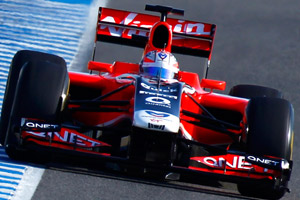it´s maybe a bit more complicated/confusing that this, and the "truth" lies perhaps somewhere in the middle.
If Cosworth made a wrong claim/estimate about the fuel consumption of their engine, then should this not affect the other teams with the Cosworth engine as well?
Or did they hover on the side of "safety" and designed a lager fuel tank just to be "safe"?
Now, for me it is conceivable that Williams and perhaps Lotus had some consumption figures of current V8 F1 engines (Toyota), and would have perhaps taken Cosworth estimates with a "grain of salt" if they seemed to be too optimistic.
But why would get HRT/Dallara the tank size correct, if Cosworth where to give them a wrong consumption figure?
On the other hand, Cosworth are no rockies when it comes to F1 engines, so I think, they would have a pretty realistic idea/understanding of the consumption of their engine.
To make matters worse, I´m sure that the same engine in two different cars, will have a different consumption, as this will depend from the drag and the weigth figures from the car.
Cosworth can run their engine on a dyno, and can give you figures for fuel consumption at a given engine load.
But they can´t know the drag levels of the car in question, and if one car has higher drag then the other, it will have more fuel consumption with the same engine.
So perhaps, Cosworth made a slight error in regards to their anticipated fuel consumption, and perhaps Virgin found that they have more drag in real life then their CFD predicted.
Which means they would need to run the engine at higher load -> more consumption.
Together with a fuel tank which was perhaps marginal to start with, this could have just pushed it over the edge.
As for the fuel density.
Which fuel supplier does Virgin use?
I did not find anything mentioned on their website.
As F1 does not use a standard fuel supplier, it could come down to what you can afford.
I could see the possibility if they go to XXX and say, we would like this high density fuel, they will be charged for the development. (assuming their chosen fuel supplier has the know how to do it, to start with)
If you can´t or don´t want to pay for this, then you have to use the "off the shelf pump fuel", which is perhaps less dense, or less powerful etc.
IMHO- this is an often overlooked fact, when talking about power gains on a "frozen engine".
While engine development is "frozen", fuel and lubrication development is not.
And I´m sure Shell,Esso(Mobil 1) and Total(Elf) are as competetive when it comes to fuel&lubricantes, as Renault,Ferrari and Mercedes when it comes to there engines.
So it´s not out of this world, for one to have a (temporary) advantage over the others, resulting in a power gain or less consumption of a "frozen" engine design.
Most often the engine supplier would specify the lubrication/fuel which has to be used with his engine.
Otherwise he has little/no control about the performance and life expectation of his engine. Or he would need to run parallel pojects to adapt/map the engines for the different fuels used by it´s customers.
This is not very likely - IMHO
Which leaves us with the question, why only Virgin got his fuel tank size wrong?
Unless they made a "silly" mistake, which would explain it, it maybe just comes down to "trying to be too smart, too fast" and sailing closer to the wind then the others.
How much fuel capacity where they "missing"?
To lose 10-12 ltr in a ~200-220 ltr. tank is not "difficult".
A wrong guess by 1% here and there, adds up pretty quick.
Just as an example, forget to calculate for the volume of the "safety foam" inside the tank, or use the wrong estimate for the foam density (been there

), having a fuel pick-up problem can easiely lose you 3-4 ltr. in a tank this size. etc. etc.
Just some thoughts, Nick Wirth and his boys will know where they went wrong, nothing wrong with that either.
Rome was not built in a day.




